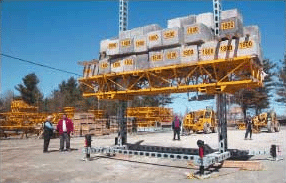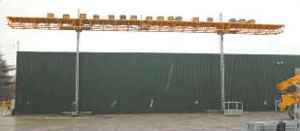Test, Test, Test and Certify
By Masonry
 Masonry was invited to witness a series of safety tests of the Bennu Innovation's mast climber in Terrebonne, Quebec. Engineers from Wiss, Janney, Elstner Associates (WJE), Northbrook, IL, conducted four test programs based on ANSI/SIA Standard A92.9 (1993) and the 2002 edition of the Chicago Building Code (CBC). This latter standard must be met to qualify a platform for use in the city of Chicago, one of the major markets for high-rise masonry.
Masonry was invited to witness a series of safety tests of the Bennu Innovation's mast climber in Terrebonne, Quebec. Engineers from Wiss, Janney, Elstner Associates (WJE), Northbrook, IL, conducted four test programs based on ANSI/SIA Standard A92.9 (1993) and the 2002 edition of the Chicago Building Code (CBC). This latter standard must be met to qualify a platform for use in the city of Chicago, one of the major markets for high-rise masonry.
Jerry Castle, president of Jerry Castle & Son Hi-Lift in Elk Grove Village, IL, explains, "All scaffolding companies that come into the city of Chicago have to have this test. The city requires them to have the test and the results to be certified because of some accidents that have happened, mostly with swing stage platforms."
In March 2002, an event happened that triggered a stronger safety-testing program for people carrying work platforms in Chicago. Three people were killed when suspended scaffolding, hanging 43 stories up the 100-story John Hancock Building, crashed to the pavement. At least three vehicles were hit by debris and ten people were transported to hospitals. Those fatally injured were inside the cars that were struck. Today the CBC tests scaffolding, not just suspended types, with an eye toward assuring workers and those nearby that a work platform can sustain more stress than the manufacturer initially planned based on the ratings the company places on the equipment.
Masonry was impressed by the work done by Bennu and WJE in setting these tests up in what turned out to be poor weather conditions (rain, cold, even snow) to show how equipment can be used in even adverse conditions with a safety margin workers can appreciate. Two platforms were used, a Bennu 90-foot Modular Power Unit (MPU) rated at 10,000 pounds capacity and a 24-foot Automated Power Unit (APU) rated at 20,000 pounds load. Each was tested at the maximum freestanding height of 30 feet (platform to ground).
 For the ANSI/SIA horizontal load test, the platforms were loaded with concrete blocks equal to the rated capacity and then raised to their test height. Next, a forklift was used to apply horizontal pressure equal to 15 percent of the capacity to deflect the platform. Sensors were used to determine the deflection and a visual inspection was made for damage afterwards. This test is intended to show the platform's ability to withstand wind when fully loaded and at maximum working height without tie-backs.
For the ANSI/SIA horizontal load test, the platforms were loaded with concrete blocks equal to the rated capacity and then raised to their test height. Next, a forklift was used to apply horizontal pressure equal to 15 percent of the capacity to deflect the platform. Sensors were used to determine the deflection and a visual inspection was made for damage afterwards. This test is intended to show the platform's ability to withstand wind when fully loaded and at maximum working height without tie-backs.
The CBC test is a vertical load test that places greater stress on the platform than the comparable ANSI/SIA test and was, therefore, considered more critical. The CBC requirements are that "the test assembly shall sustain, without failure, superimposed loads equal to 2.5 times the design live load." Blocks weighing 26,400 pounds were placed on the MPU platform and 50,000 pounds was used with the APU. They were raised to maximum freestanding height and left in that position for 24 hours. Sensors measured the vertical deflection and the amount and speed of recovery once the load was removed. The ANSI test only calls for 150 percent (1.5x) of rated capacity so the CBC is even more stressful.
According to Brian Santosuosso, the WJE project engineer, "The Bennu 24-foot APU and 90-foot MPU are capable of supporting the ANSI-specified [horizontal and vertical] test loads. In addition, the platform is also capable of supporting the CBC load of 2.5 times its rated capacity. The assembly remained stable throughout all the tests and exhibited good deflection behavior under the test loads."
The APU recovered immediately from the deflection caused by the load; the 90-foot MPU recovered within 4.5 hours. Both are well within the standard requirements.
Testing for safety comes naturally to equipment manufacturers. Companies such as Bennu go out of their way to test at maximum rated load and multiples of maximum to show they have over-engineered their assemblies. By having test laboratories, not in-house groups, do the evaluation, the results are accepted by stringent codes such as Chicago's.
About the Author
Masonry, the official publication of the Mason Contractors Association of America, covers every aspect of the mason contractor profession - equipment and techniques, building codes and standards, business planning, promoting your business, legal issues and more. Read or subscribe to Masonry magazine at www.masonrymagazine.com.


















